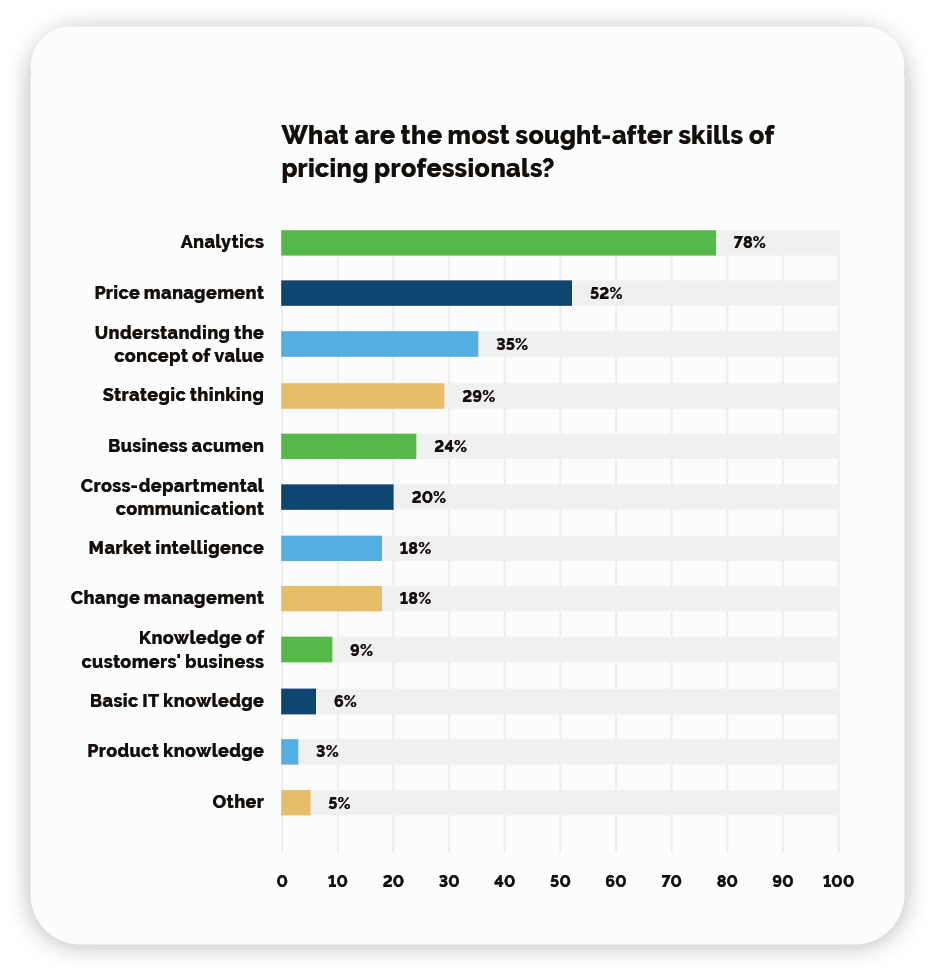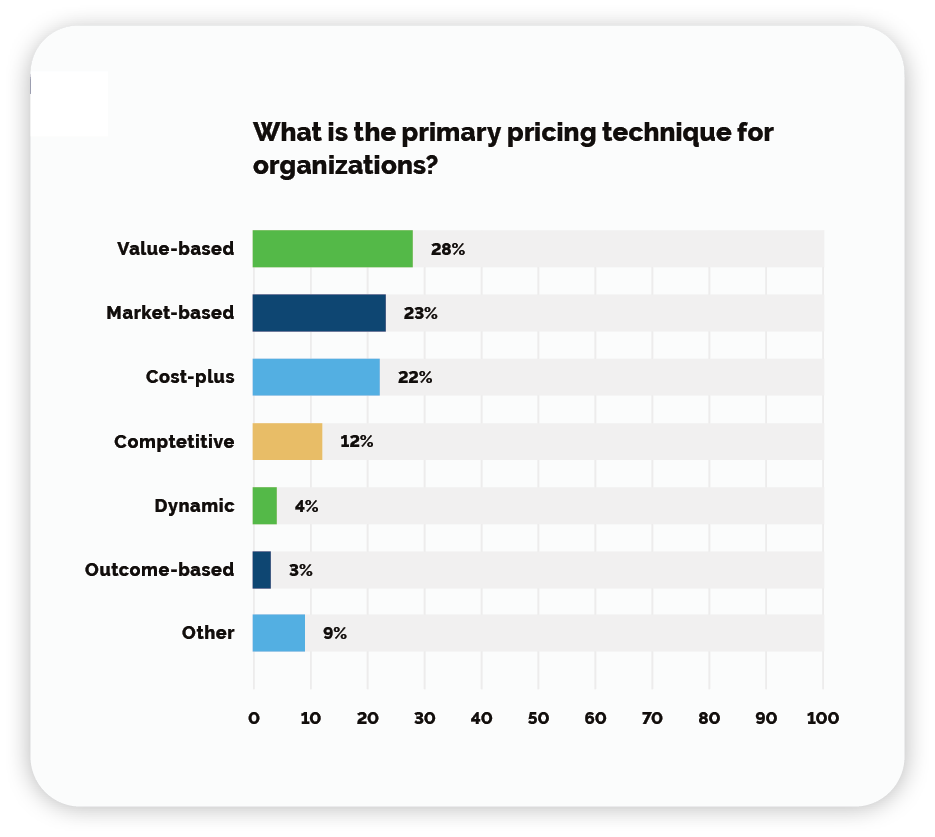
Vendavo’s Pricing Excellence Report and Outlook 2024 surveyed the industry’s top pricing professionals for their views on pricing talent, maturity, challenges, pricing models, and more. Morgan Short, Director of Content & Web Strategy covers some of the highlights from the research and unpacks how organizations can build their pricing strategy, bridge the C-suite gap, quantify pricing impact, and embrace AI’s influence.
How much thought goes into pricing your products? Is it a quick look at costs with a standard mark-up? If so, that’s a good start but there is so much more that goes into delivering the right price, for the right customer, at the right time. What will it take to satisfy your customers’ expectations? How much are they willing to pay? And don’t forget – what do you need to be profitable?
Price optimization is the process of deciding the most effective pricing for a product or service. It is how organizations find the optimal price their customer is willing to pay for a product: not so high that they risk losing that customer’s business, not so low that they sacrifice margin. While counter-intuitive, price improvement has a greater positive impact on the bottom line than cost-cutting.
When it comes to optimizing your pricing for superior customer experiences and profitability, the Pricing Excellence Report and 2024 Outlook from Vendavo and Copperberg highlights 8 key trends to take note of today.
- Pricing authority is moving to sales and marketing teams
While pricing hasn’t historically been a part of the day-to-day for most sales and marketers, that tide is turning. Pricing authority has shifted primarily to sales and marketing teams (54%), up 11 percentage points from 2022. As organizations work to manage revenue goals in a fiercely competitive landscape, empower your sales and marketing teams to do more, with greater granularity by educating them on pricing data and processes.

- Most pricing teams are 5 people or less
If you’re fortunate enough to have dedicated, pricing professionals, a small team generally seems to do the trick for most. A significant number of organizations (56%) rely on just 1 to 5 people. One reason this can work is growing pricing software adoption. To do more with less, leverage pricing optimization software and employ innovative pricing models.

- Pricing Analysis is a competitive advantage
One way to gain a competitive edge is to prioritize key pricing skills for future employees and provide ample training for current employees. Overwhelmingly, the most valued skill for pricing today is strong pricing analysis (75%). The volume of dynamic data to be considered for arriving at the right price for the right customer is significant, including market trends, product preferences, buyer sentiment, transaction history, and more. If you’re able to grow your team, hire someone with strong pricing analysis skills to sort through the data. If not, identify someone on your team that has the willingness to hone those skills. It will pay off. Pricing optimization software will help them organize, analyze, and report the data – and most importantly, provide context for actions that improve win rates and profitability.

- One pricing model does not fit all
With many prices to manage, “choosing” a pricing strategy is a bit of an oversimplification. Multiple strategies are usually needed to govern tactics spread across multiple product lines, sales regions, or even customer types. However, most (28%) report a preference for the value-based pricing model. This is how you meet your customers’ expectations without leaving money on the table. The key is to evaluate the effectiveness of your current pricing approach and consider different pricing methodologies as needed. To understand what those different models are, read: Mastering B2B Pricing Strategies: Comprehensive Guide with Examples

- Agility is the name of the game
While inflation and supply chain disruptions are constantly changing factors, competitive pressures are not. Agility in the form of data collection, deeper understanding of your customers and their buying patterns, and swift, seamless price changes with sales guidance are the culture of pricing agility. Begin tracking any data point, no matter how small, and be ready to act on it.
- Bridge the gap with the C-Suite
A good relationship between pricing and the C-suite is crucial for driving pricing initiatives, gaining executive buy-in for pricing decisions, and aligning pricing strategies with broader business objectives. While most report they have this strong tie in place, a concerning 24% say the relationship is poor. This is a problem because when the C-suite understands and supports the pricing function, it becomes easier to secure necessary resources, implement pricing changes, and drive pricing as a strategic lever for business success.
- Quantify the financial impact of pricing
Quantifying the impact of pricing is crucial for understanding the value and effectiveness of your pricing strategies. It allows organizations to assess the ROI delivered by your pricing teams and demonstrates commercial maturity and excellence. If you don’t yet quantify pricing impact, consider implementing robust measurement methodologies and tools to evaluate the ROI and performance of their pricing strategies.
- Explore and evaluate AI in pricing
Like virtually every other industry, AI is making a big impact on pricing. Algorithms can rapidly and accurately analyze vast amounts of data, saving time and effort in identifying patterns, and predict customer actions by aggregating information on market trends, historical transactions, and competitor actions. It can bring disparate information sources together and quickly facilitate short cuts to efficiency seeking prompts and measure KPIs. For these and plenty of other reasons, more than half (51%) report using AI to some degree, or they are devising plans to implement it in the next year. While the long list of possibilities for AI in pricing trends is exciting, it’s important to remember its use should be a blend of both human and machine intelligence. Consider AI your co-pilot in establishing the right price with ample flexibility and teamwork between your internal teams and your AI technology stack.
Final Thoughts on Pricing Trends
Before we close out this article on today’s top pricing trends, here’s a quick refresher on what price optimization is not: lowering prices may win more deals, but that success might not be evident on the bottom line, unfortunately. Margins will suffer, profitability will plummet, and your leadership will want to know what’s going on. Rather than quick, seat-of-the-pants, across-the-board price cuts, identify your customers’ willingness to pay for specific products, and be ready to price accordingly.
